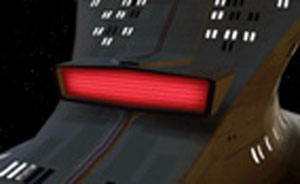
.
.
The
basics of Impulse Engine design as employed by the United Federation of
Planets, and most
other
major powers, have remained more or less static for almost a century
now. In general,
Impulse
engines consist of four main components :
The
fuel tank contains the reactants used within the engine. Starfleet uses
simple Deuterium fuel -
less
efficient than a Deuterium/Tritium mix, but Deuterium is far easier to
produce and handle than
Tritium,
while using only one type of fuel eliminates the necessity for two independent
sets of fuel
storage
and handling systems within the ship.
Once
the fuel has left the tanks, it is reduced in temperature to form pellets
of solid Deuterium ice
of
variable diameter. These are fired into the reactor where a set of fusion
initiators are used to
ignite
the pellet whilst a magnetic field holds them in place. The Deuterium atoms
are fused
together
according to the equation :
Which
gives the conversion of mass to energy a theoretical maximum efficiency
of 0.08533% - in
practice
never quite reached by actual engines. The standard Impulse fusion reactor
as used in
the
Galaxy class Starship is a sphere six metres in diameter, constructed of
dispersion-strengthened
hafnium excelinide. The reactors can be networked together, with each
one
passing its plasma output to another in a cascade fashion. Each of the
eight Impulse engines
on
a Galaxy class starship has three fusion reactors connected together in
this manner.
Once
the Deuterium has fused successfully, the plasma stream created is passed
through the
next
major component - the space-time driver coil. Under the Einsteinian physics
which holds true
for
objects at sub-warp velocities it is virtually impossible for a simple
fusion rocket to deliver
sufficient
energy to accelerate a spacecraft to near light speed - the fuel requirements
rapidly
increase
to the point where the large majority of the vessel would be dedicated
to fuel tankage. The
coil
avoids this situation by generating a sub-warp cochrane field around the
vessel, reducing its
effective
mass in order to boost the acceleration.
Actual
Impulse flight performance is therefore dependant not only on the specifications
of the
fusion
reactors, but also on the capabilities of the driver coils. One of the
fastest ships ever fielded
in
terms of Impulse performance was the refit Constitution class. This ship
was capable of
reaching
'Full Impulse' (25% c) in a matter of seconds. At the other end of the
scale the much later
Ambassador
class was designed to achieve a far more lowly acceleration of 10,000 ms-2,
sufficient
to reach Full Impulse in 125 minutes.
Once
the plasma stream has passed through the driver coil assembly, it reaches
the exhaust port
and
passes into space. If the coil itself is not engaged, the Impulse Engine
reverts to behaving like
a
simple Newtonian fusion rocket with a performance thousands of times less
than its normal
capabilities.
Under these circumstances the exhaust system is designed to vector the
thrust of the
engine
in order to correct for unusual mass distributions or provide off-axis
thrust for enhanced
agility.
At
velocities which are an appreciable fraction of that of light, time dilation
becomes a factor for
Starship
crews. When a ship travels very near to the velocity of light, this effect
can become very
significant.
For example, at the 92% c which is the maximum velocity of the Galaxy class
Starship
over
2.5 days would pass for a stationary observer for each day which passed
for the crew. In
order
to keep these effects below a 3.5% time differential, the Federation has
long imposed a ban
on
Impulse flight above velocities of 0.25 c - so called "Full Impulse" -
on all normal missions.
While
this restriction is not applicable during combat operations, the effects
of time dilation can
have
extremely adverse effects on a vessel in these conditions - a crew can
find themselves in a
position
where their reaction time will be greatly reduced compared to an enemy
because of the
difference
in velocities between them. High relativistic speeds are therefore generally
avoided
altogether
by Starships.
Early
space vessels had to mount so called "retro-rockets" in order to slow themselves
down as
they
approached their destination, or else turn their craft backwards and use
the main engines to
slow
down. One further advantage of utilizing the driver coil in an Impulse
engine is that this rather
cumbersome
requirement is removed. The driver coil essentially allows the ship to
reduce its
mass
in order to allow a - relatively - small amount of kinetic energy to create
a great deal of
velocity.
Once the coil is discharged, the ship returns rapidly to its normal mass.
The kinetic
energy
remains constant, so the velocity is vastly reduced without any need to
use the engines
thrust.
In
theory, the coil alone could be used to drive the ship by simply adjusting
the mass so that the
velocity
reaches the desired level. In practice, however, it is not that simple.
The coil cannot be
simply
turned up and down as required, but is rather discharged and then recharged
by the flow of
plasma
through it - essentially, by the normal operation of the impulse engine.
It is thus not
possible
to 'tune' a ships mass up and down as required. Overcoming this limitation
has been the
holy
grail of Impulse engine designers for well over a century, but as yet no
progress has been
made.